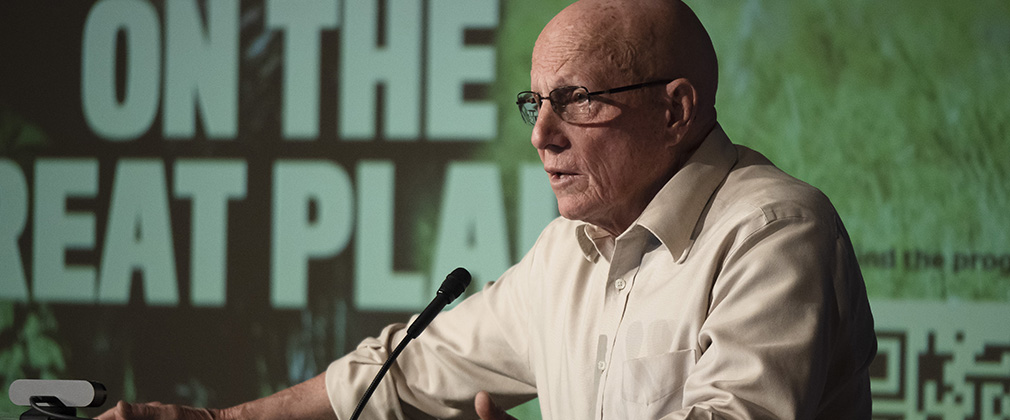Wild Ideas on the Great Plains
19th Annual Edward and Nancy Dodge Lecture
December 11, 2019

Program | Video | Viewpoints
Preserve the Prairies, Respect the Buffalo
BALTIMORE—Dec. 5, 2019. “What must it have been like when there were 50 million buffalo on these prairies?” asked Dan O’Brien, sharing what went through his mind as he contemplated replacing the cattle on his small ranch with bison.
A writer, biologist and rancher from South Dakota, O’Brien told the story of how his work with peregrine falcons brought him to buffalo, and how his style of raising the animals—which includes not only the care and feeding, but also the slaughter—evolved alongside his beliefs about the past and the future. He spoke at the Bloomberg School, as a guest of the Johns Hopkins Center for a Livable Future’s 19th Annual Edward and Nancy Dodge Lecture.
O’Brien is an owner of Wild Idea Buffalo Company and the Cheyenne River Ranch in South Dakota, and what started as a small ranch with 13 orphaned bison has expanded to 900 bison. He was happy to report that for the most part, he leaves the animals alone, letting them feed and take care of themselves, intervening now and then to make sure they respect the fences that border his land. Unlike cows, bison are native to the United States and “hardly notice if it’s winter or summer.” In extreme temperatures, cows will huddle in riparian zones (land bordering rivers), where they do some ecological damage; the bison, unruffled by weather, do no such thing.
“We’ll go weeks, sometimes months, without seeing them,” he said.
On ecologically sound prairie lands, prairie grasses are able to sequester carbon, both above ground in the leaves and below ground in the roots, which can extend for eight to 14 feet.
“I try to use that land the way it evolved to be,” said O’Brien.
His bison feed on grass—and only grass—that grows on the prairie, which sets them apart from almost all of the bison meat produced in the US. Most bison is raised in feedlots and finished on corn, which puts on pounds quickly but is not healthy for the animals. The ranch also does “humane field harvests” of the bison, slaughtering them not in industrial slaughter facilities, but one at a time by a sharpshooter who rides into the prairie in a pickup truck.
He and his staff pay respects to the animals before the harvest—“It’s not hunting, it’s a harvest,” he says—and conduct ceremonies such as burning sage, thanking the grandfathers, blessing the rifle and making offerings of tobacco in the six directions. For these ceremonies, he consulted a ceremonial technician from the Lakota Nation, Rocke Afraid of Hawke, whose telling of the Wind Cave origin story O’Brien quoted.
“The buffalo promised to give us everything we need to survive,” he read from one of his books. “You know what the buffalo ask for in return? Love. Respect. That’s the deal.”
The attention O’Brien gave to bison harvest is a topic not many are willing to tackle publicly. And yet it’s a fundamental part of any meat production operation.
“Sugar-coating it is a sin,” he said. “Slaughter of buffalo is a tricky subject. No one likes to kill them. I’m a fanatic about feedlots and industrial slaughter, and a little militant, too, so watch out.”
O’Brien came to South Dakota in 1970 as a wildlife biologist and ornithologist, traveling up and down the Rocky Mountains in a government-funded effort to restore the peregrine falcon population. As the falcons came off the endangered species list, he started exploring the ecosystems around him.
“If you got birds, you got a healthy ecosystem,” he said. “And to get birds, you need buffalo on the Great Plains.”
Recently O’Brien has been working with the family of Ted Turner, who owns most of the commercially produced bison in the country (about 51,000 animals), to explore alternatives to their production methods, which include feedlots and industrial slaughter.
“The buffalo should die in same pasture where they were born and raised,” he said. “It shows respect, that way of harvesting.”
—Christine Grillo
The Edward and Nancy Dodge Lecture is supported through the R. Edward Dodge, Jr. and Nancy L. Dodge Family Foundation Endowment, established through the generosity of Dr. Edward Dodge, MPH ’67, and his late wife Nancy to provide core funding for the Center for a Livable Future.